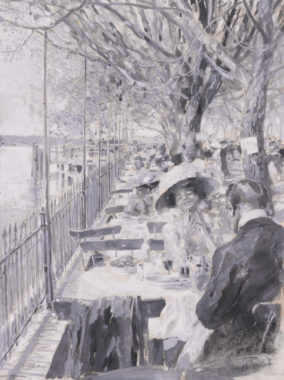Stahl, Friedrich
Sold Artworks
Biography
Friedrich Stahl
1863 Munich – 1940 Rome
Friedrich Stahl moved to Berlin on completion of his studies at the Munich Academy of Art in 1888. In 1892, in protest at the restrictive and intensely conservative exhibition policies of officialdom he joined Ludwig von Hofmann, Walter Leistikow and eight other artists in founding the Vereinigung der XI [Group of Eleven]. With its elitist exhibition programme, the association quickly attracted public attention. It paved the way for the Berlin Secession but remained in existence until 1899.
Modern life in the imperial capital held a powerful attraction for Stahl. Unlike the Berlin artists Adolph Menzel and Franz Skarbina, who were well established in the city and also specialised in urban themes, Stahl had very little interest in the lifestyle of the ordinary population. Instead, he applied his illustration skills and talent for satirical imagery to depictions of the leisured, sophisticated lives of the middle classes and minor aristocracy. His spectrum of themes ranged from the hustle and bustle of urban life on boulevards and squares to intimate tête-à-têtes at balls and elegant soirées where high society whiled away the time exchanging pleasantries or by flirting and dancing. Stahl usually chose grisaille or bodycolour as his medium, recording his observations in a fluid, impressionistic style which captured the fleeting nature of the moment and heightened the impression of lightness and elegance. From 1899 onwards, the Munich-based humoristic magazine Fliegende Blätter was to publish over 350 of these drawings. They convey a very vivid impression of the zeitgeist of the German belle époque and its hedonistic attitude to life.
Stahl lived in England from 1898 to 1904. Here, he engaged intensively with the work of the Pre-Raphaelites, whose stated intention was to return to the values of Italian early Renaissance art. This stimulated Stahl’s interest in deepening his own knowledge of Italian art and he moved to Florence in 1904. In the nine years of his stay in Italy his oeuvre underwent a radical change. From then onwards, his painting reflected the influence of the Quattrocento both in style and subject matter. Austerely composed paintings depicting religious, literary and mythological themes executed in a glazing technique reminiscent of the Old Masters and suggesting a strain of sadness at the loss of bygone beauty superseded the insouciant urban-life images of the turn of the century. Although these new, dreamily mystic paintings were essentially anachronistic, critical reactions were nonetheless broadly positive.
Stahl moved back to his native Munich in 1913, before returning to Italy in 1920. He spent the last two decades of his life in Rome, where he was honoured with a major retrospective to commemorate his seventy-fifth birthday.
PDF Download

